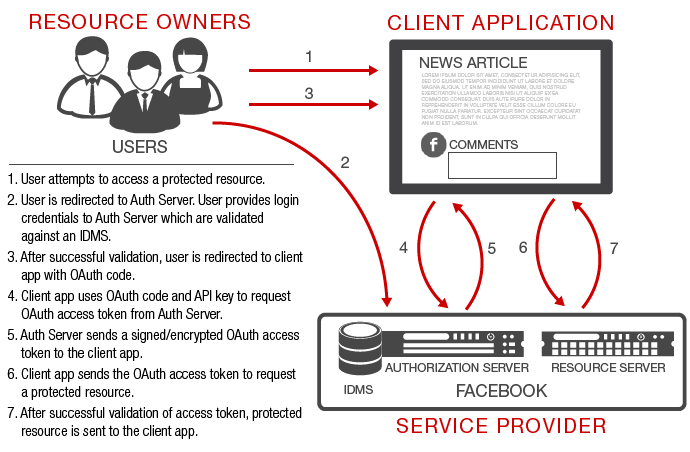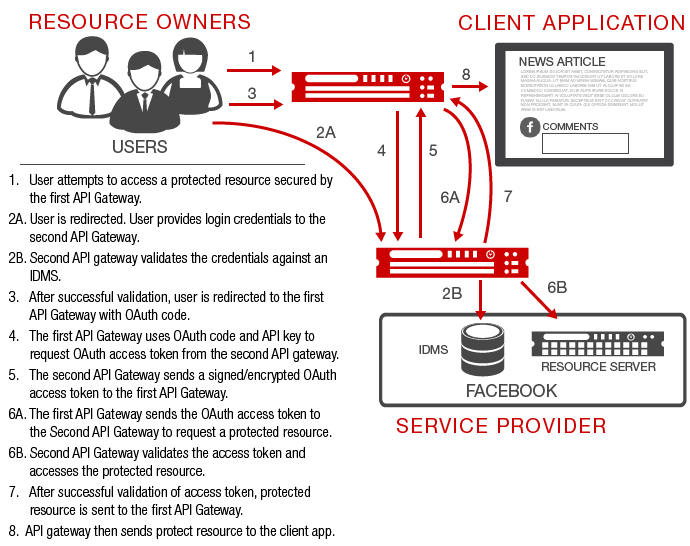OAuth
Introduction to OAuth
[/promobox]
Over time, social media sites such as Facebook, Twitter, LinkedIn, and Google have become the defacto repositories of a user’s social identity or profile. The availability of existing social identities with rich profile data provided an opportunity for sites to access user data outside their domain of control. OAuth is an identity standard that enables sites to access user profile data outside their domain of control without requiring users to pass their username, password to the site.
The Figure below illustrates a simple example that leverages OAuth. A news media site (client application) that provides an option for a better social experience by allowing a user (resource owner) to post a comment on an article with the user’s facebook profile attributes (name, photo, location) displayed next to the comment. The user in this example, grants control to the news media site to fetch its facebook profile attributes from the facebook site (service provider) without ever revealing an email or password to the news media site.
[/promobox]
Overview
The popularity of social media apps, mobile apps and cloud services has introduced another authentication and authorization model. In this model, at a minimum, three actors are involved. The three actors are the user, client application and the service provider. This is often referred to as the three-legged OAuth model. The user is the owner of the resource and it grants client application access to its resources that are controlled by the service provider. OAuth standard enables the user to grant client application to its resources without ever sharing its username/password with the client application.A simple example of OAuth
Traditionally, it is the social media applications that have been the main drivers behind OAuth deployment. In the past, web applications such as news media sites would maintain their own user profile data by providing the option to each of its users to create custom profile on the site for better user experience. This approach had many shortcomings for both users and media sites:- Users had to provide email or username and password for each site during the initial creation of a profile.
- Users would often forget their passwords during the login process since they had created multiple profiles at different sites.
- Media sites were now responsible for securing their users’ emails and passwords from hackers.
- Users would often create fake profiles that would provide inaccurate tracking data to media sites.
White Paper
Enterprise Integration with Public Cloud Services using OAuth The figure above is a common use case where a user (resource owner) is accessing a new media site (client application) to post a comment on an article using a Facebook account. Before the comment can be posted, the news media site fetches the user’s facebook profile attributes (user owned resources) from facebook (service provider). The granting of access to resources owned by the user to the client application on behalf of the user is enabled by the the OAuth standard.
The figure above is a common use case where a user (resource owner) is accessing a new media site (client application) to post a comment on an article using a Facebook account. Before the comment can be posted, the news media site fetches the user’s facebook profile attributes (user owned resources) from facebook (service provider). The granting of access to resources owned by the user to the client application on behalf of the user is enabled by the the OAuth standard.
OAuth White Paper
Cloud-based Enterprise Identity Management using OAuthOAuth with API Gateways
The flexibility and power of OAuth introduces complex transactional interaction between the parties in the three-legged OAuth model. Although the previous example demonstrates a common use case, there are multiple design time and run time interactions that take place behind the scenes between different parties. The previous example is expanded to illustrate the run time interactions that take place to enable a seamless user experience.OAuth Transactional Flow in 3-Legged Model

- Client application, service provider security application (authorization server, resource server) have to be modified to integrate with OAuth toolkit or library. This means developers have to be involved in the integration process.
- Tracking multiple versions of OAuth standards now becomes the responsibility of the integration development team.
- There is no centralized management of OAuth tokens and their expiry, as OAuth is integrated across multiple applications .
- Applications have to be trusted to generate, consume and validate correct and secure tokens.
- Complex transport mechanisms such as HTTP redirects have be added to existing applications.
- Tracking and isolating an issue within OAuth becomes more difficult since it is tightly coupled with applications.
OAuth with API Gateways in 3-Legged Model

- Plug-n-play with no modification to client applications and service provider applications.
- Centralized management and enforcement of OAuth tokens and their expiry.
- API gateways with hardware assist provide a more secure mechanism in generation and validation of secure tokens.
- API gateways can scale to handle large number of OAuth requests.
- Complex transport mechanisms such as HTTP redirects are simple policy configurations in API gateways.
- Tracking and isolating an issue within OAuth is easier since OAuth is loosely-coupled with applications.